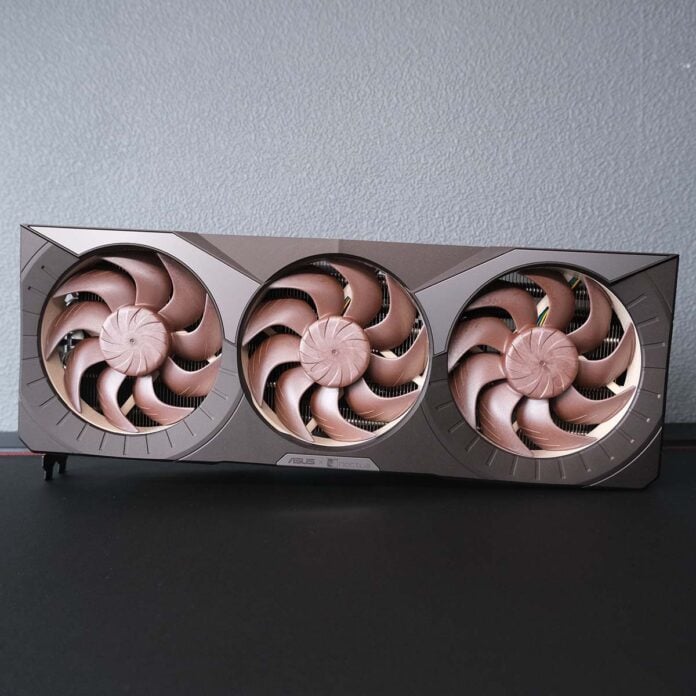Cooler quality and fan noise can make or break a graphics card, having returned a fair few in my time based on their sound profile alone. Suffice to say I value quiet components, but nothing has come close to matching the golden silence that has graced my ears after testing the Asus GeFore RTX 5080 Noctua OC Edition. It’s proven a proper pin drop moment.
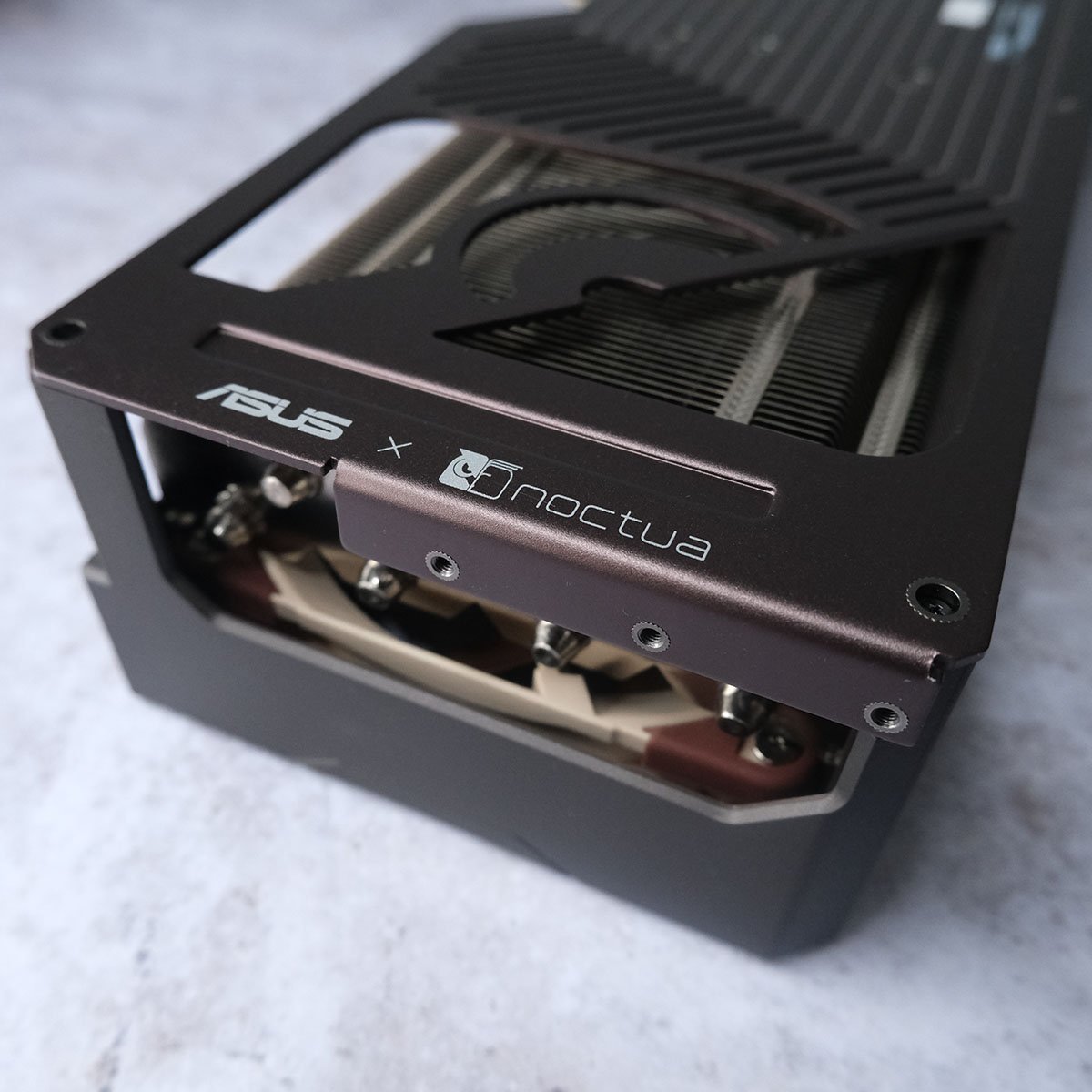

Asus GeForce RTX 5080 Noctua OC
£1,499 / $1,599
Pros
- Best-in-class acoustics
- Fantastic thermal management
- Outstanding build quality
- Lots of overclocking headroom
- Great QHD/UHD performance
Cons
- Massively expensive for RTX 5080
- Demands a large chassis
Club386 may earn an affiliate commission when you purchase products through links on our site.
How we test and review products.
This fusion of Asus and Noctua smarts is awesome from a technical standpoint. A cooling apparatus that can keep a 360W GPU cool and near-silent under load? Count me in. A price of £1,499 / $1,599 does temper value, but doesn’t diminish the promise of performance.
Design
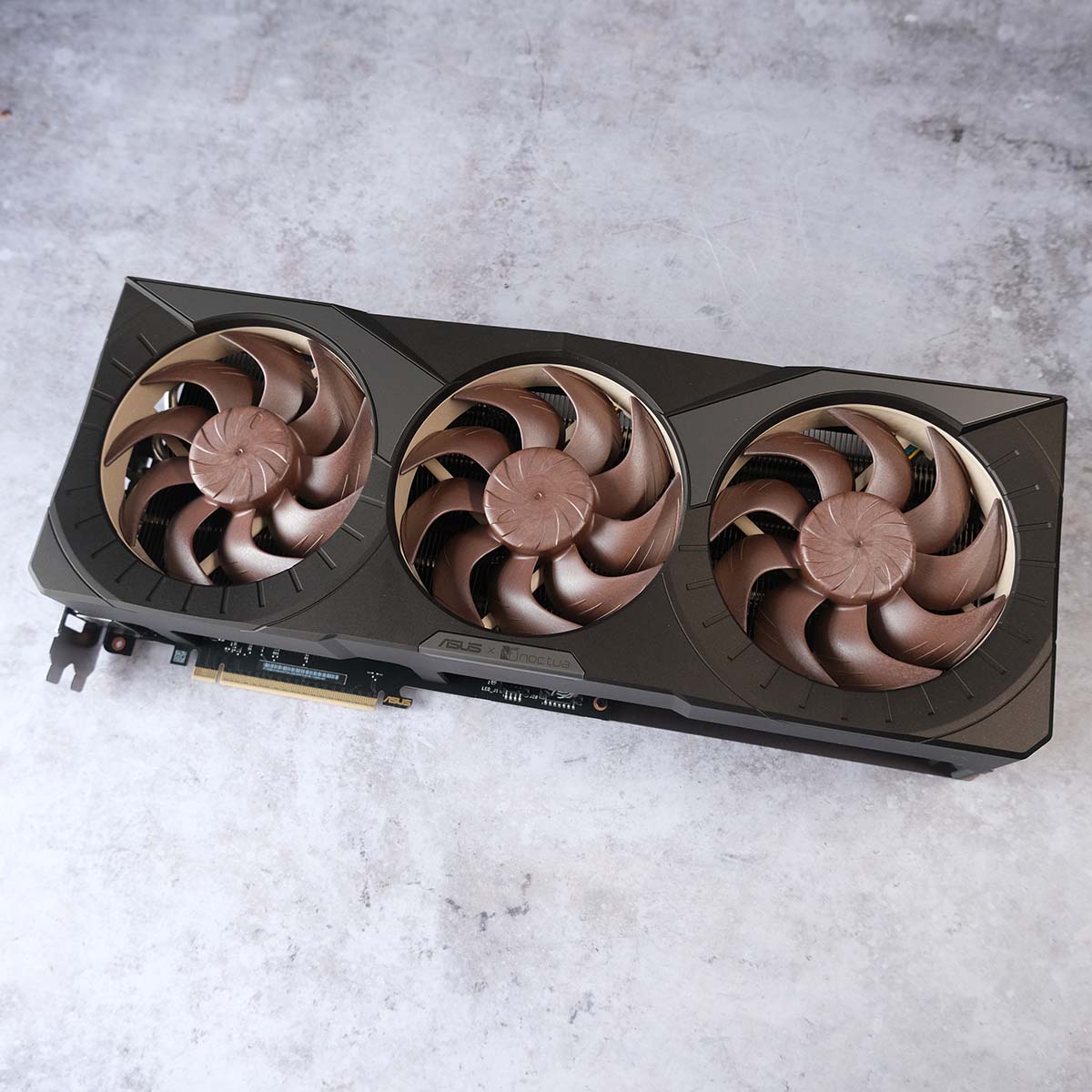
This graphics card marks the fifth collaboration between Asus and Noctua, which began back in 2021 with a custom RTX 3070. The brands’ latest joint effort carries over plenty of lessons learned in that time, but also signals the advent of several shifts in design.
The most obvious difference between RTX 5080 Noctua OC Edition and its several predecessors is size. This card is a triple-fan, quad-slot monster, weighing 2.7kg and measuring 385 (H) x 151 (W) x 80mm (H).
These measurements dwarf previous Noctua graphics cards and even give a lot of other RTX 5080 coolers a run for their money. This size makes it difficult to house the pixel pusher in all but the most-spacious cases, but there is brain behind this brawn.
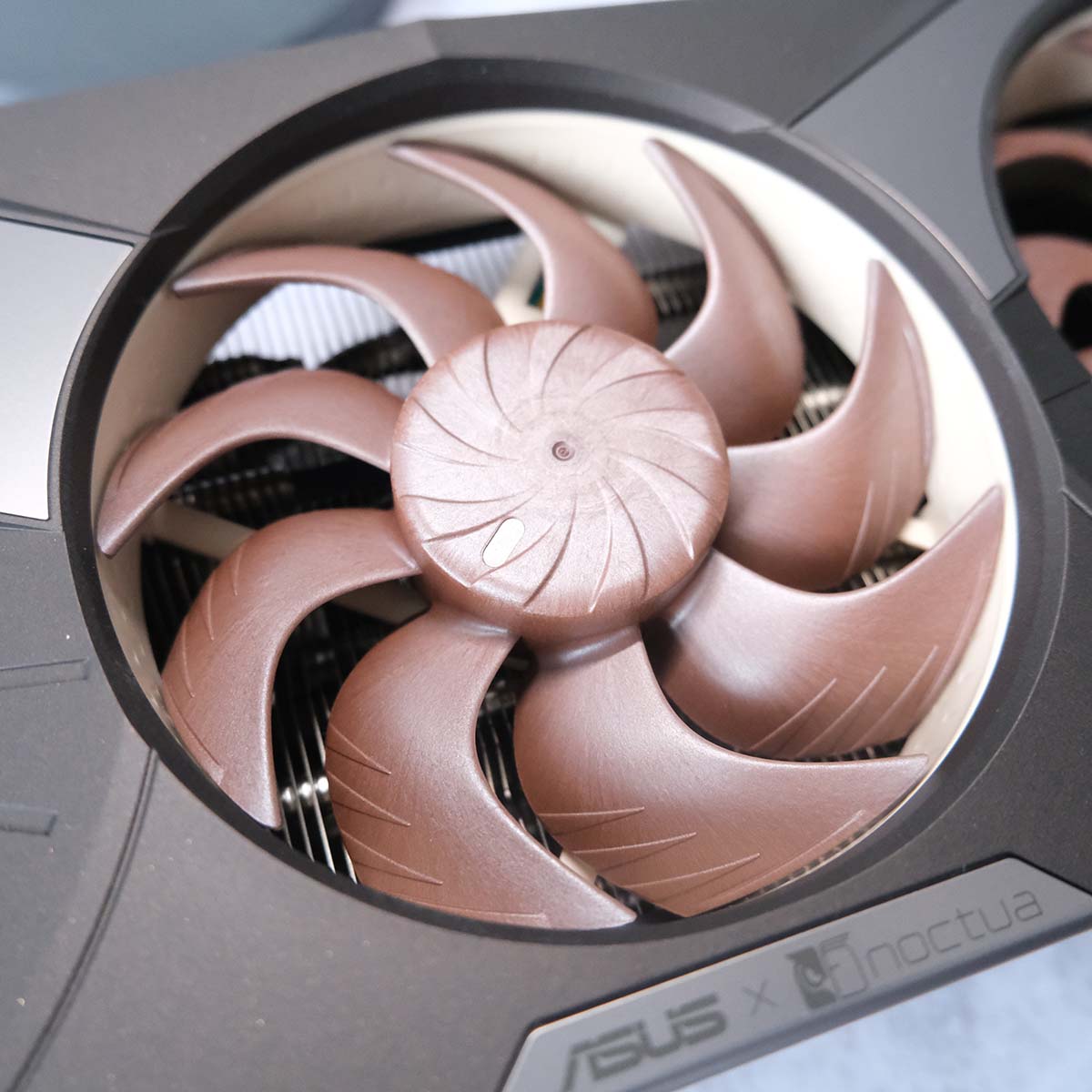
In the shroud are three full-size NF-A12x25 G2, the brand’s flagship 120mm fans. Speaking from experience, these blowers offer excellent acoustics and airflow credentials, so it’s nice to see their cooling magic at work on a graphics card.
To further fine-tune noise levels on this RTX 5080, Noctua offsets the speed by +/-50rpm of each fan in an A-B-A configuration. This keeps the likes of humming and other undesirable qualities at bay for a smoother acoustic profile. It’s exactly the sort of attention to detail you’d expect from the Austrian firm.
Near-silently as these fans spin, they won’t actually kick into action until the GPU reaches 55°C. Until that point, the card will happily passively cool itself without making so much as a whisper.
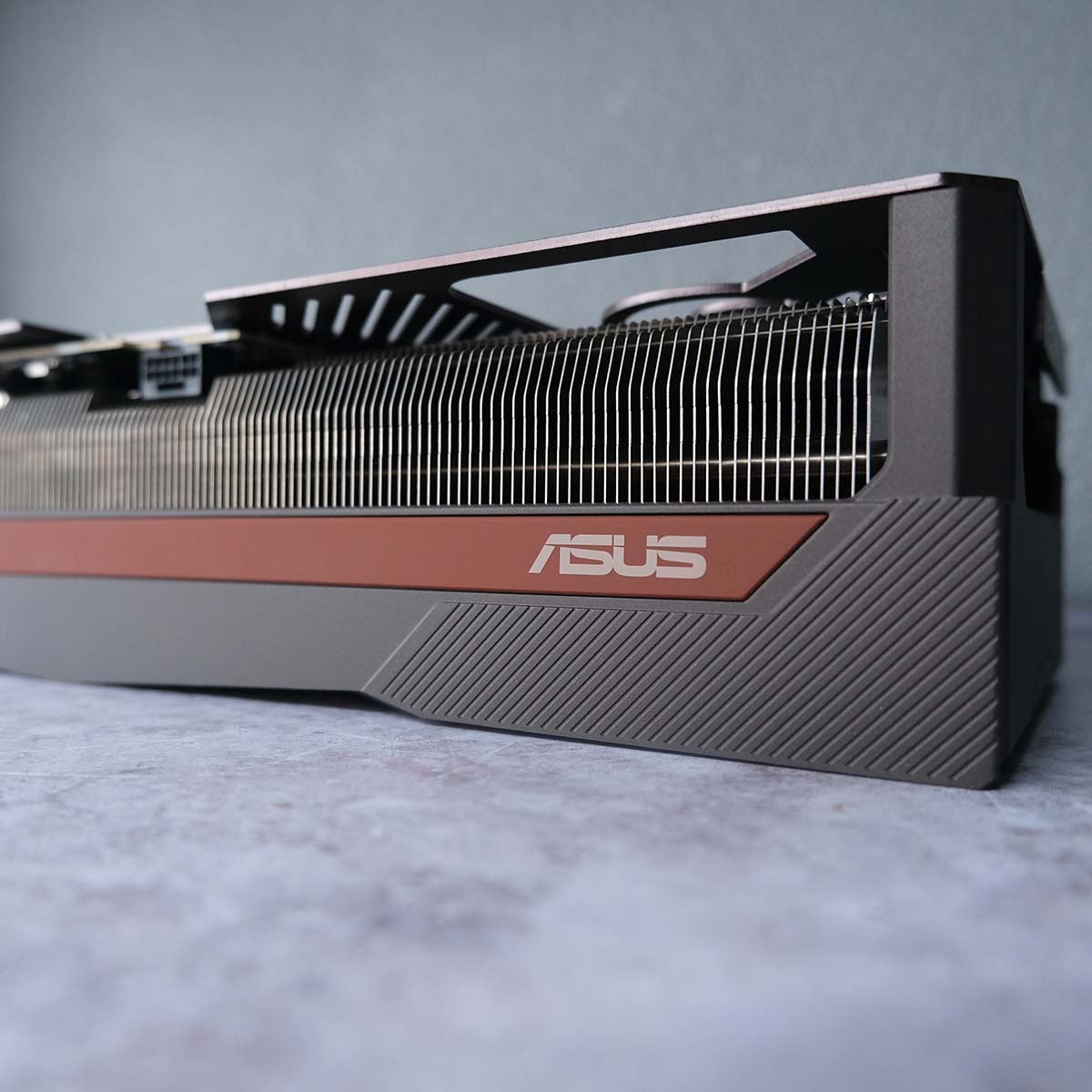
In addition to unique fans, this RTX 5080 also sports a custom heatsink. Noctua and Asus have designed it with the card’s NF-A12x25 G2 fans in mind, specifically to capitalise on the blowers’ pressure capacity.
Pull away the shroud and a supremely dense fin stack reveals itself. Look closer and you’ll find seven 8mm and four 6mm heatpipes alongside a vapour chamber. For context, Asus’ TUF Gaming card only rocks four of the larger pipe size.
Bolstering cooling capacity further is a phase-change thermal pad atop the GPU. This interface promises greater conductivity and heat dissipation than thermal paste as it liquifies under heat, minimising gaps between die and heatsink. It’s a level of over-engineering hardened PC enthusiasts will appreciate.
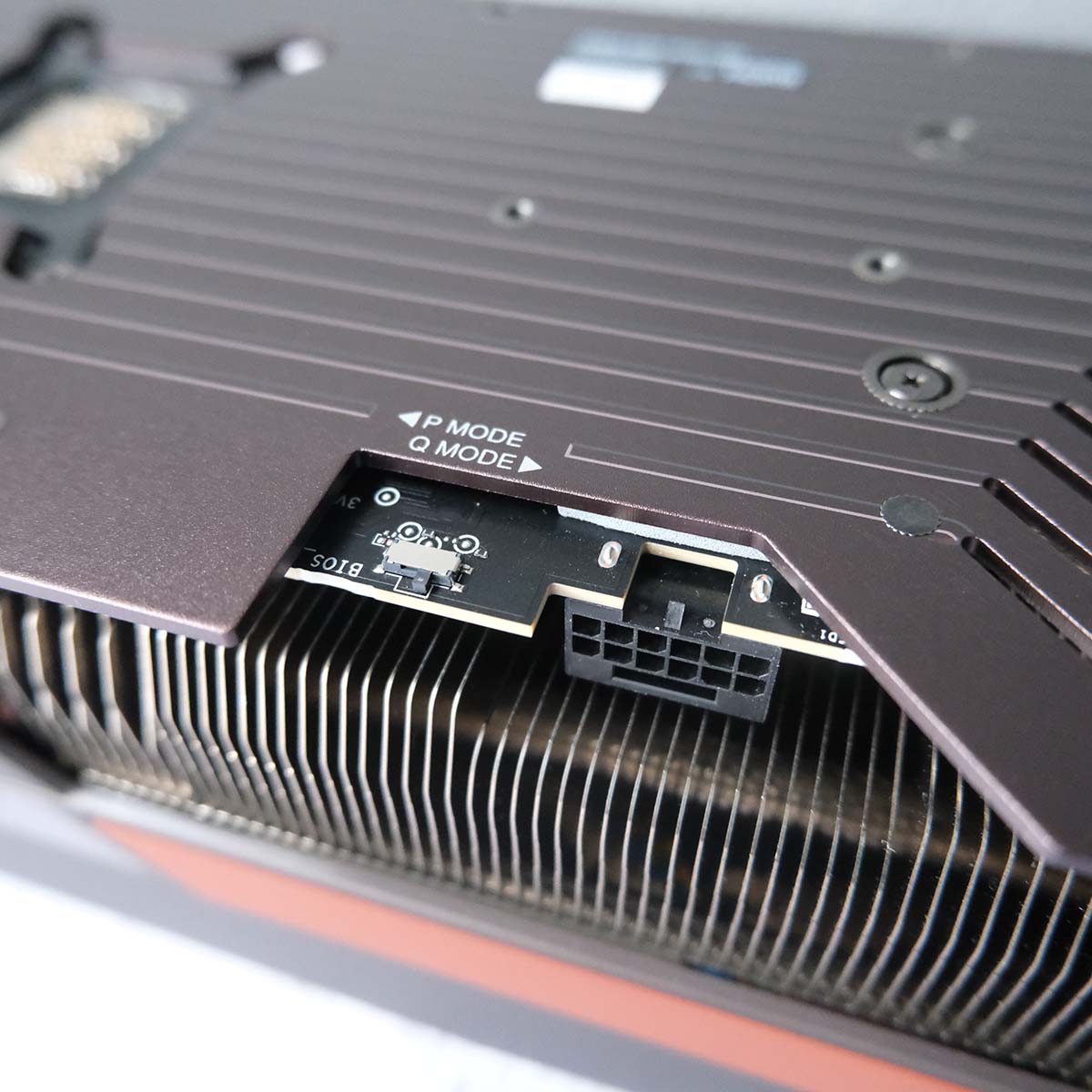
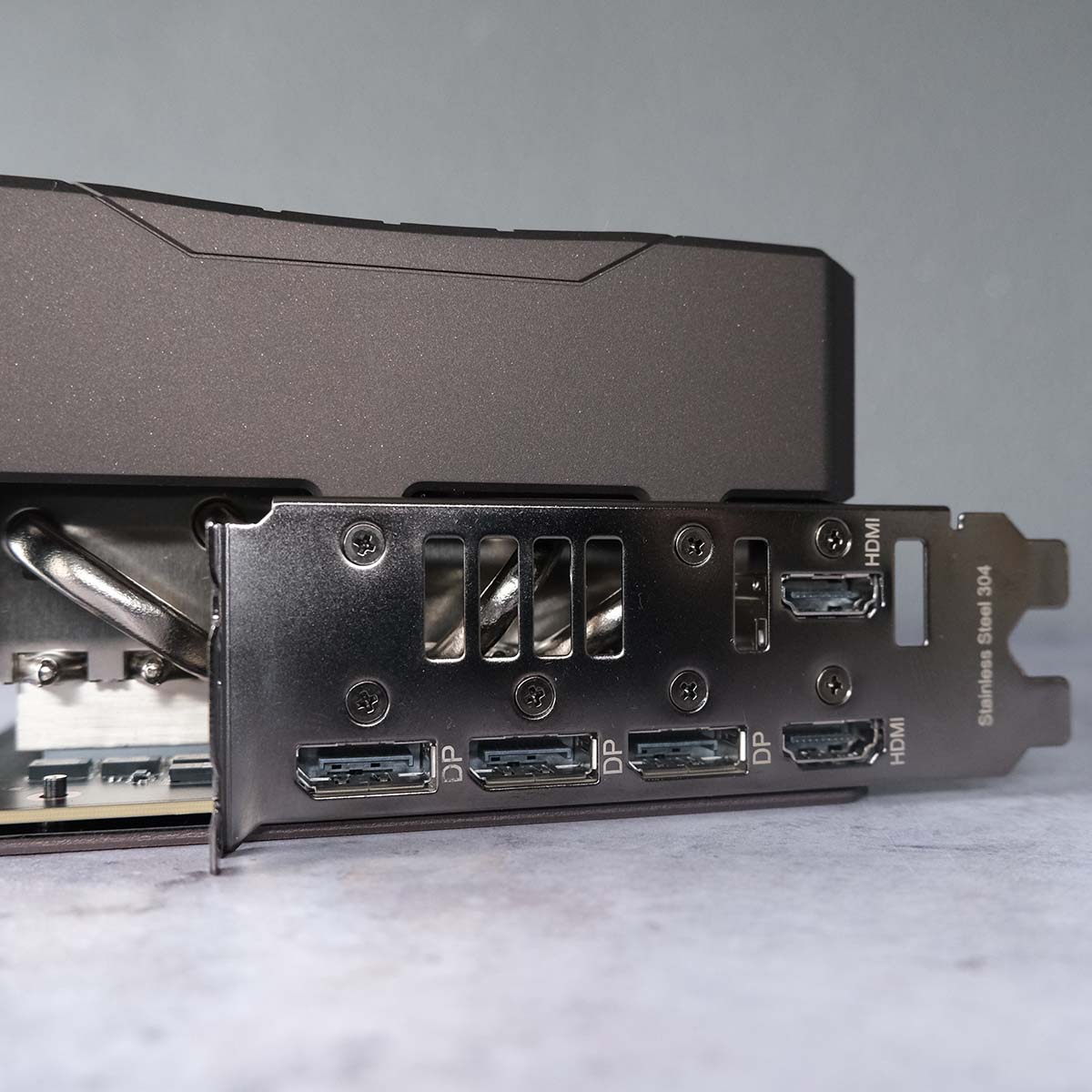
Features aren’t the focus of RTX 5080 Noctua OC Edition, least of all RGB. That said, the card does come with a few welcome touches.
Chief among them is a dual BIOS, which arrives in ‘Q Mode’ (Quiet Mode) alongside an alternate ‘P Mode’ (Performance Mode). Switching between the two will tune the aggressiveness of the fan curve, but in my experience there’s really no need to swap from the default even while overclocking.
Unlike Founders Edition, RTX 5080 Noctua OC Edition comes flush with not one but two HDMI 2.1 ports, in addition to the customary three DisplayPort 2.1 outputs. I’m always happy to have more display options.
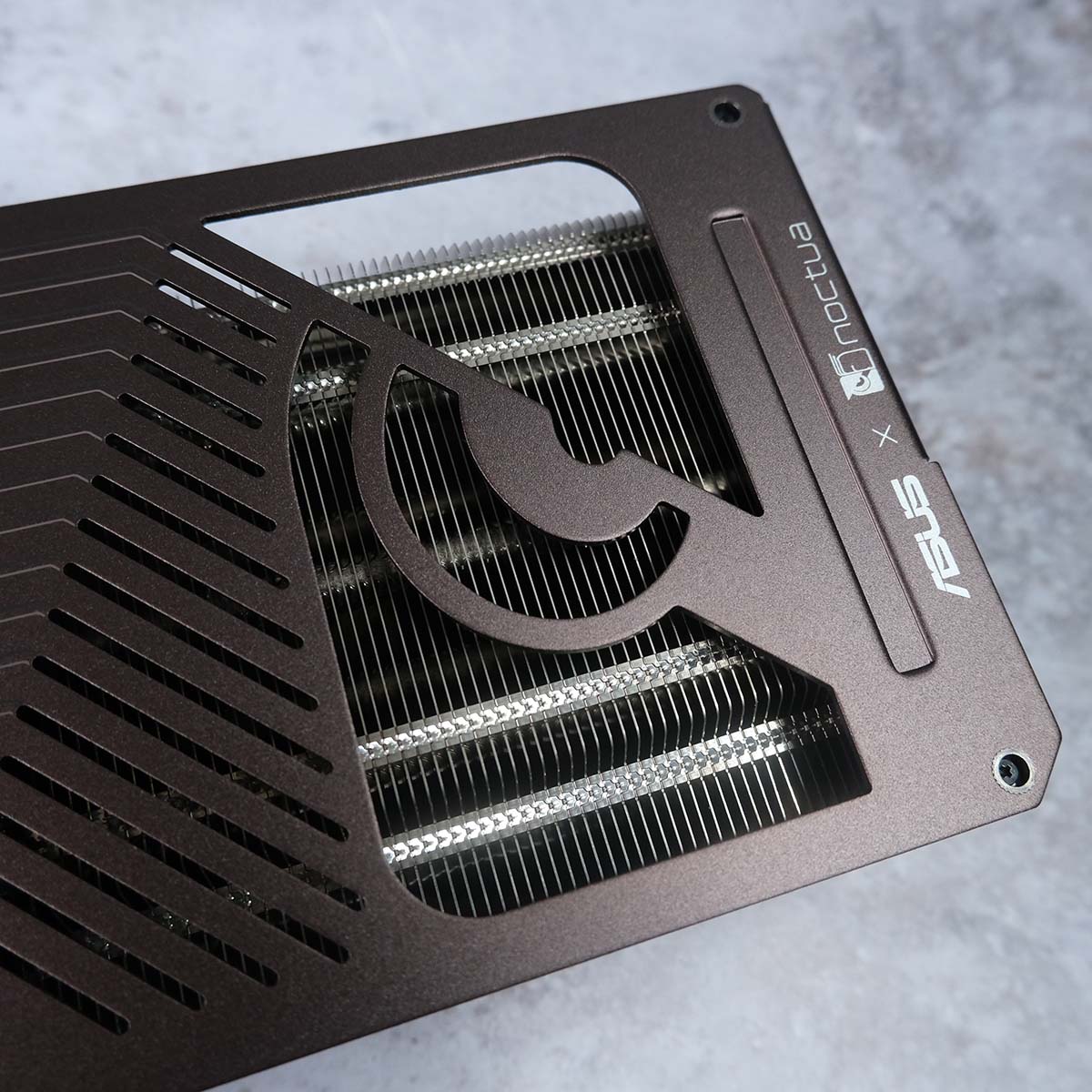
Striking as I find Noctua’s trademark brown-beige colour scheme, I appreciate it’s not to everyone’s tastes nor the easiest to cohesively work into a build. As far as I can recall there’s never been a chromax.black graphics card, but oh boy, a card of this stature, decked out entirely in black, would without doubt be the Caped Crusader’s weapon of choice.
This graphics card is subtler in its appearance horizontally, while vertical mounting would prove trickier but not impossible. I adore how Asus and Noctua have been able to create a likeness to the latter’s owl logo with the faceplate.
There’s a nod to that iconic bird on the backplate too. Is this stencil the ideal shape for cooling? Probably not. Does it look cool? Absolutely.
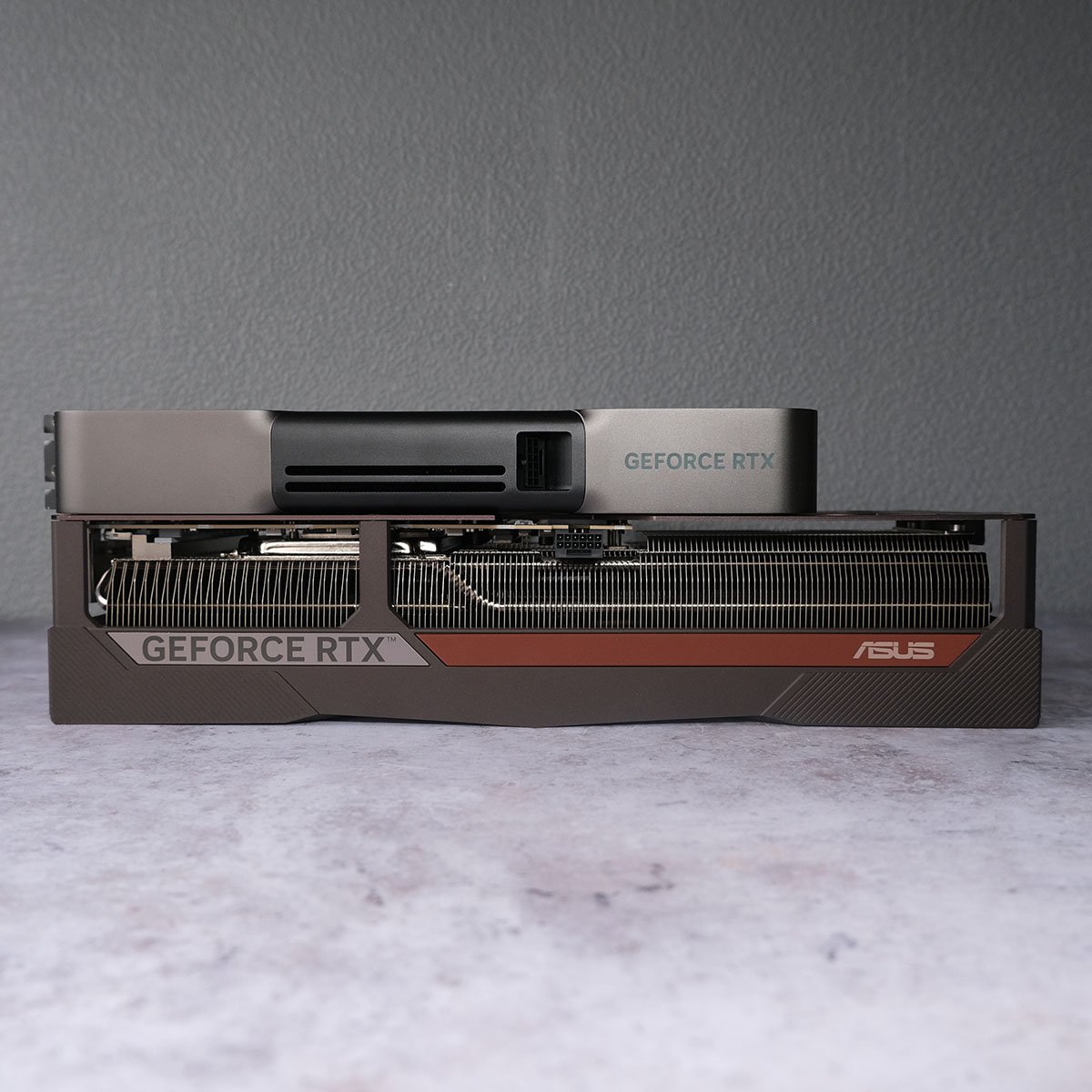
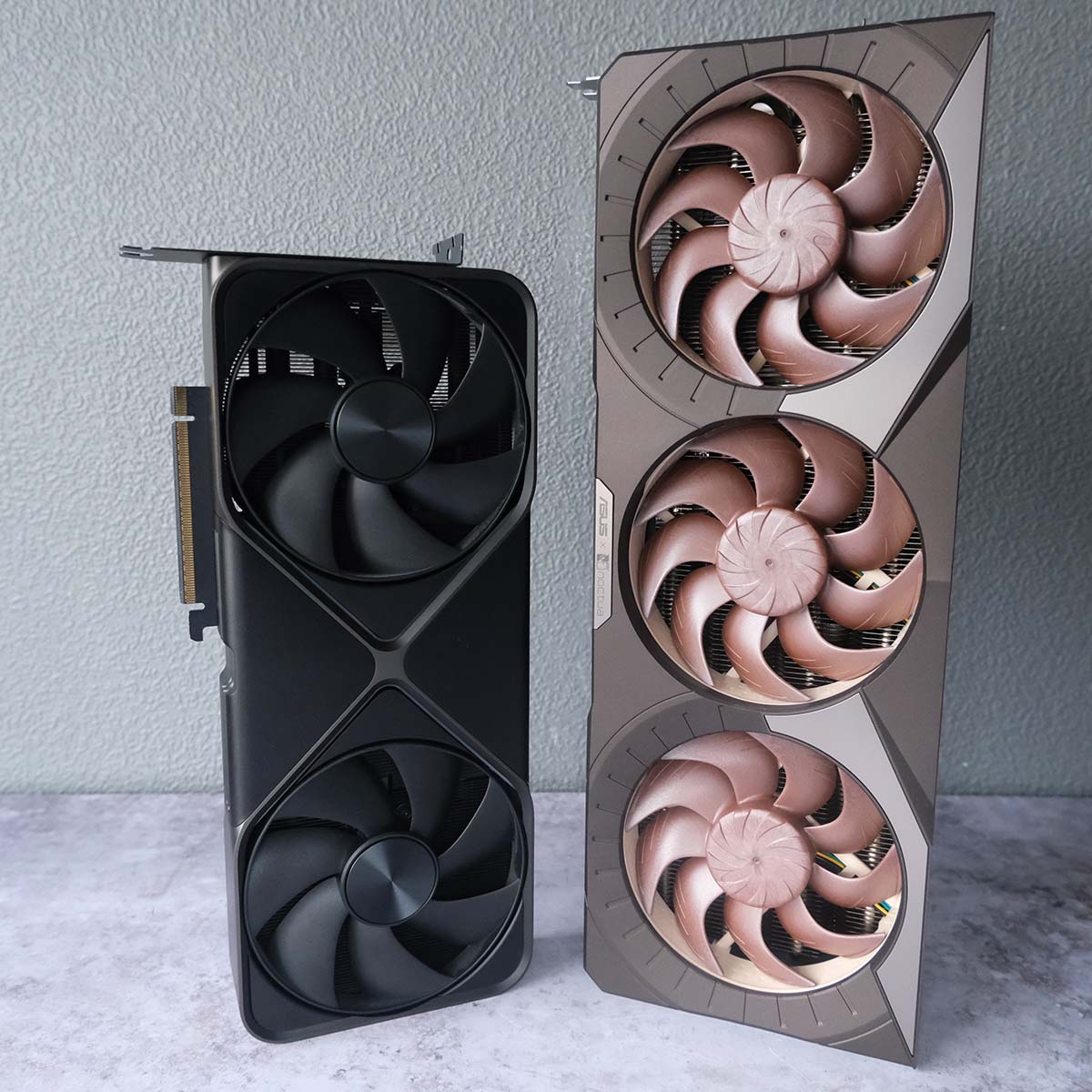
As much as size and colour scheme may deter some builders, both factors pale in this regard compared to the card’s price. At $1,599 / £1,499, this is the most-expensive examples of an RTX 5080 out there. Heck, liquid-cooled cards are available for less.
This is no small uplift from MSRP either, which I should remind you is £949.99 / $999.99. That’s a whopping 50% premium for all this Noctua engineering.
While there is nothing else like this RTX 5080 on the market, the question then becomes how much value you place on its uniqueness. The price point remains undeniably intimidating regardless, and let’s not forget, if you’re spending this amount of money, the all-singing, all-dancing RTX 5090 Founders Edition can be had for £1,799, stock depending. What’s an extra £300 or so between enthusiasts?
Performance
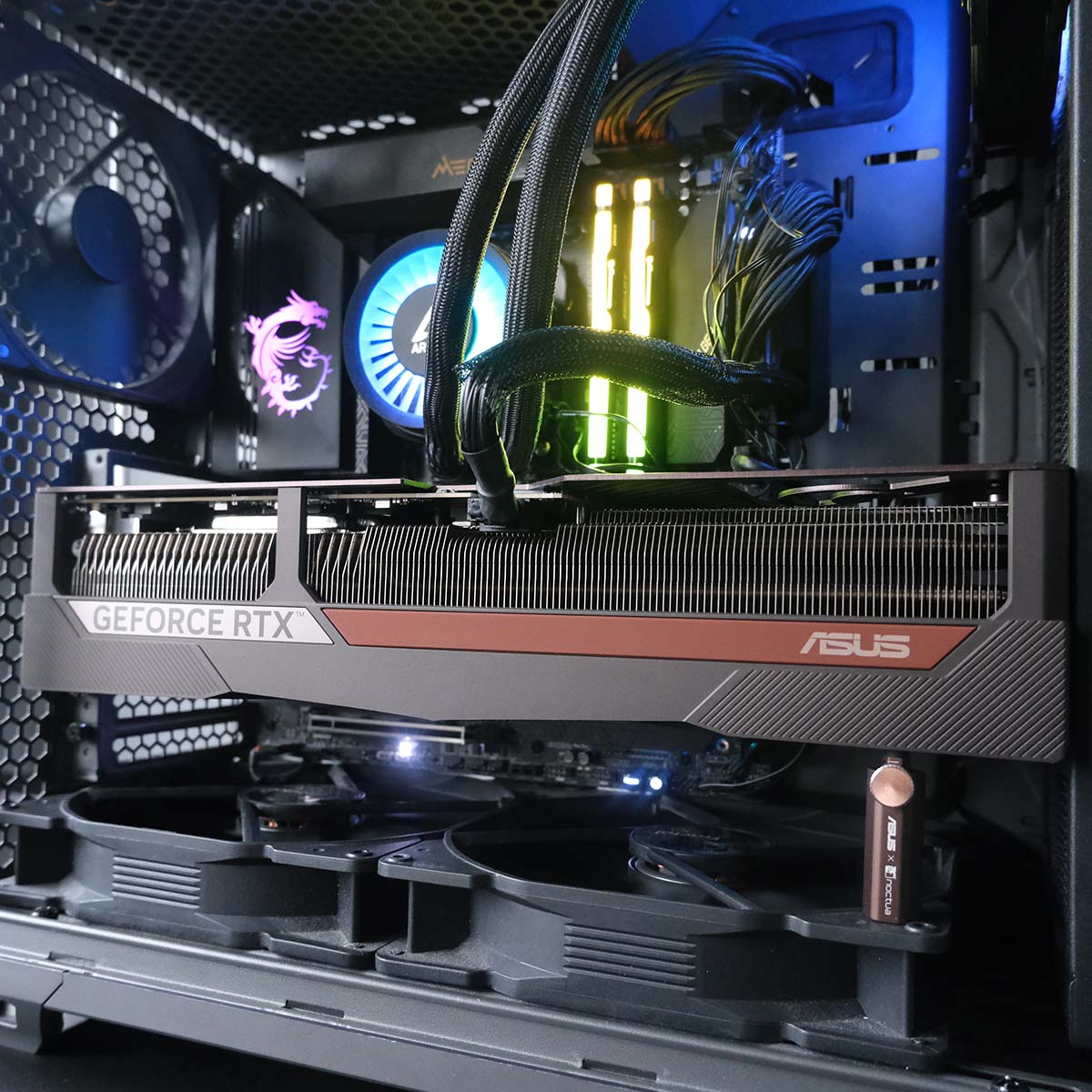
To put RTX 5080 Noctua OC Edition on equal footing with previous graphics card results, it’s time to call on the Club386 test bench.
However, the system is running with two fewer Arctic P14 A-RGB case fans to accommodate the enormity of this pixel pusher’s shroud. This will have a knock on effect to thermal and acoustic results but to a minor extent.
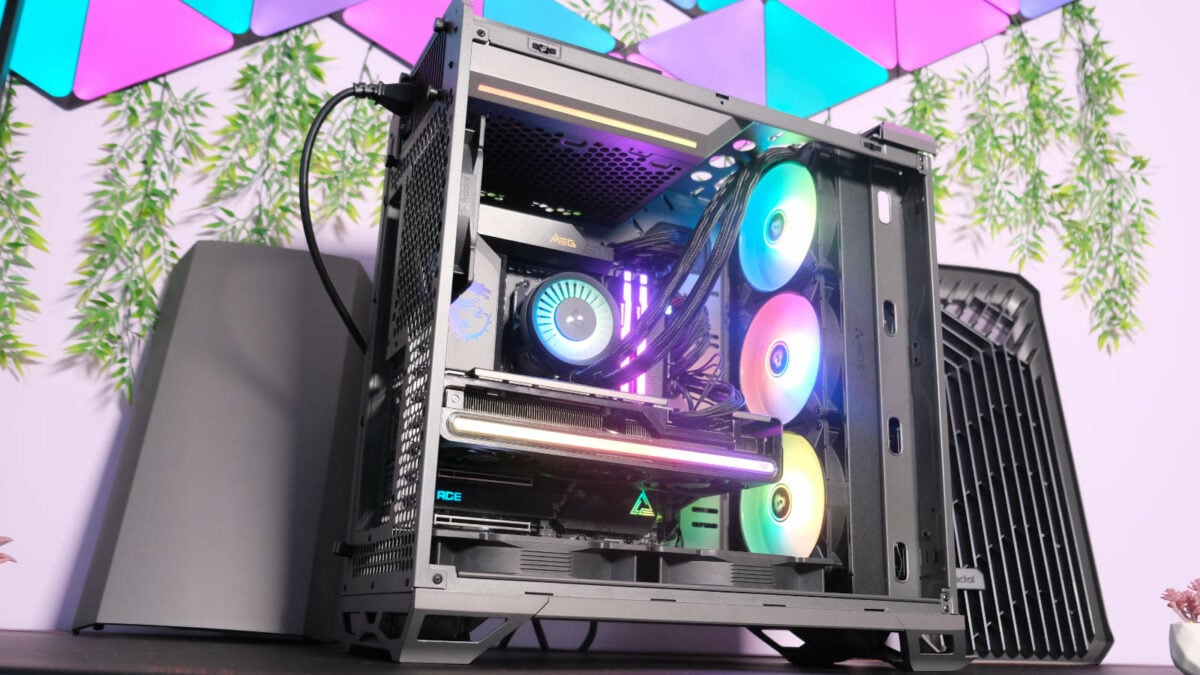
Our 7950X3D Test PCs
Club386 carefully chooses each component in a test bench to best suit the review at hand. When you view our benchmarks, you’re not just getting an opinion, but the results of rigorous testing carried out using hardware we trust.
Shop Club386 test platform components:
CPU: AMD Ryzen 9 7950X3D
Motherboard: MSI MEG X670E ACE
Cooler: Arctic Liquid Freezer III 420 A-RGB
GPU: Sapphire Nitro+ Radeon RX 7800 XT
Memory: 64GB Kingston Fury Beast DDR5
Storage: 2TB WD_Black SN850X NVMe SSD
PSU: be quiet! Dark Power Pro 13 1,300W
Chassis: Fractal Design Torrent Grey
Unique as RTX 5080 Noctua OC Edition is, the underlying Blackwell silicon remains the same as other models. As such, I’ll be focussing less on general performance and instead zone in on the card’s noise levels, overclocking potential, as well as power draw and noise.
I strongly recommend reading our RTX 5080 Founders Edition review for further detail on the GPU.
Application
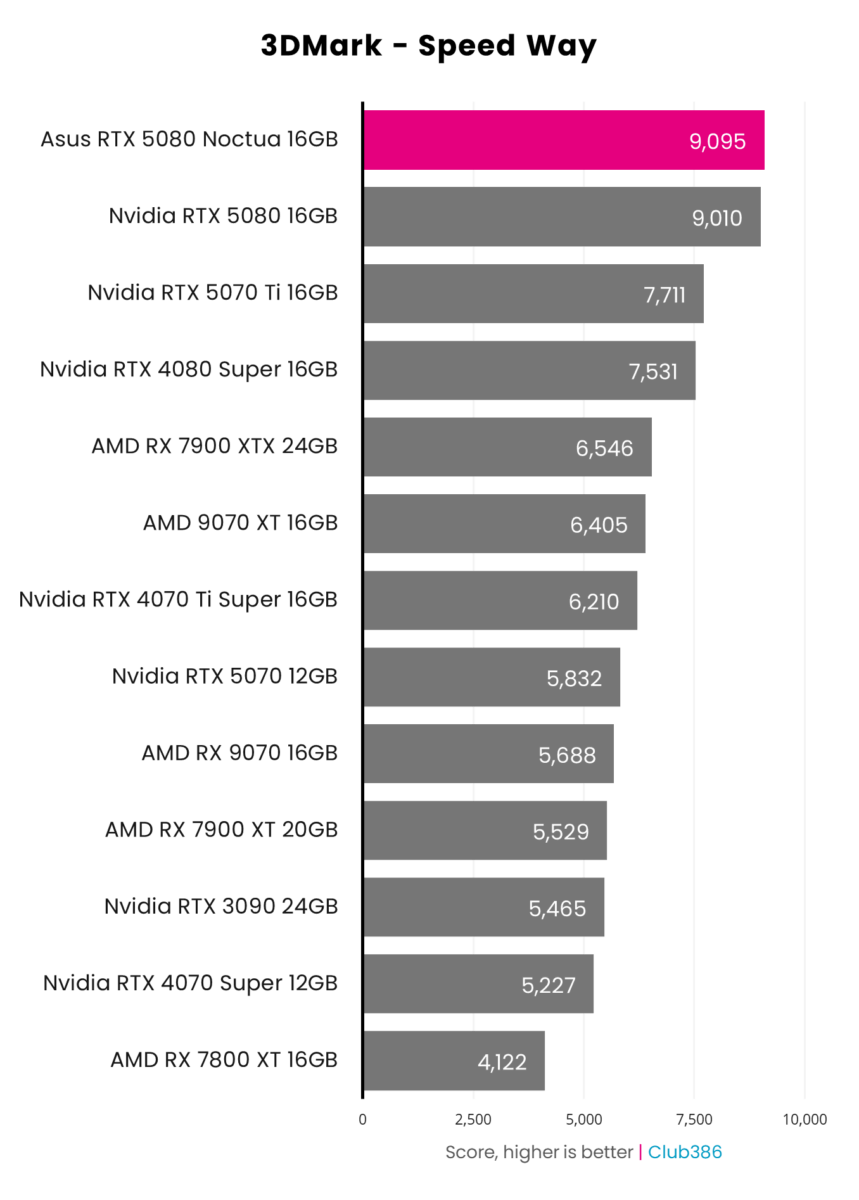
3DMark Speed Way puts graphics card ray tracing abilities to the test at QHD resolution, conditions in which RTX 5080 thrives. Noctua OC Edition doesn’t push performance far beyond stock but does emerge top of the chart nonetheless.
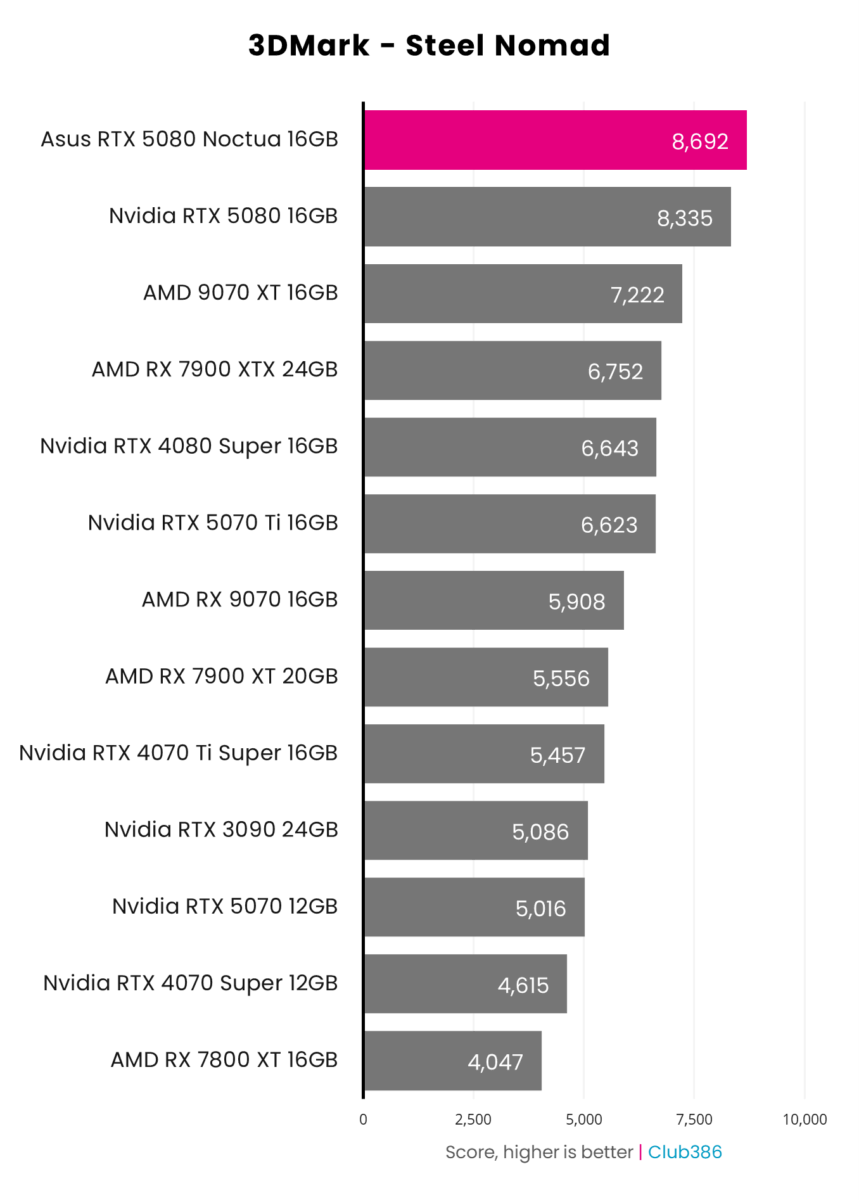
3DMark Steel Nomad cranks resolution to 4K and swaps ray tracing for rasterised rendering. In the face of this more traditional workload, RTX 5080 Noctua OC Edition shines a little brighter with a more pronounced performance uplift of 4% relative to Nvidia’s Founders Edition.
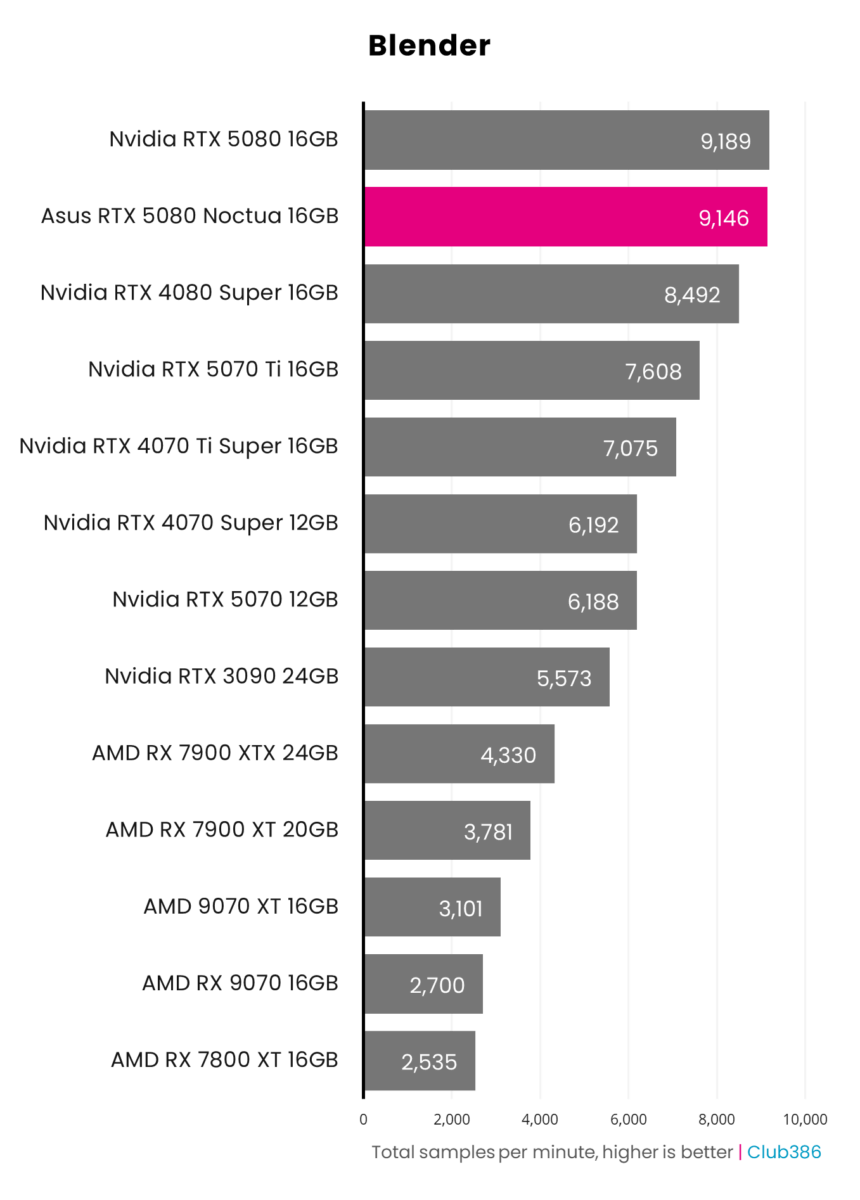
RTX 5080 Noctua OC Edition is curiously a few samples short of matching Founders Edition in Blender. The difference is negligible, though, to the point you’d find it nigh on impossible to notice a difference in real-world use.
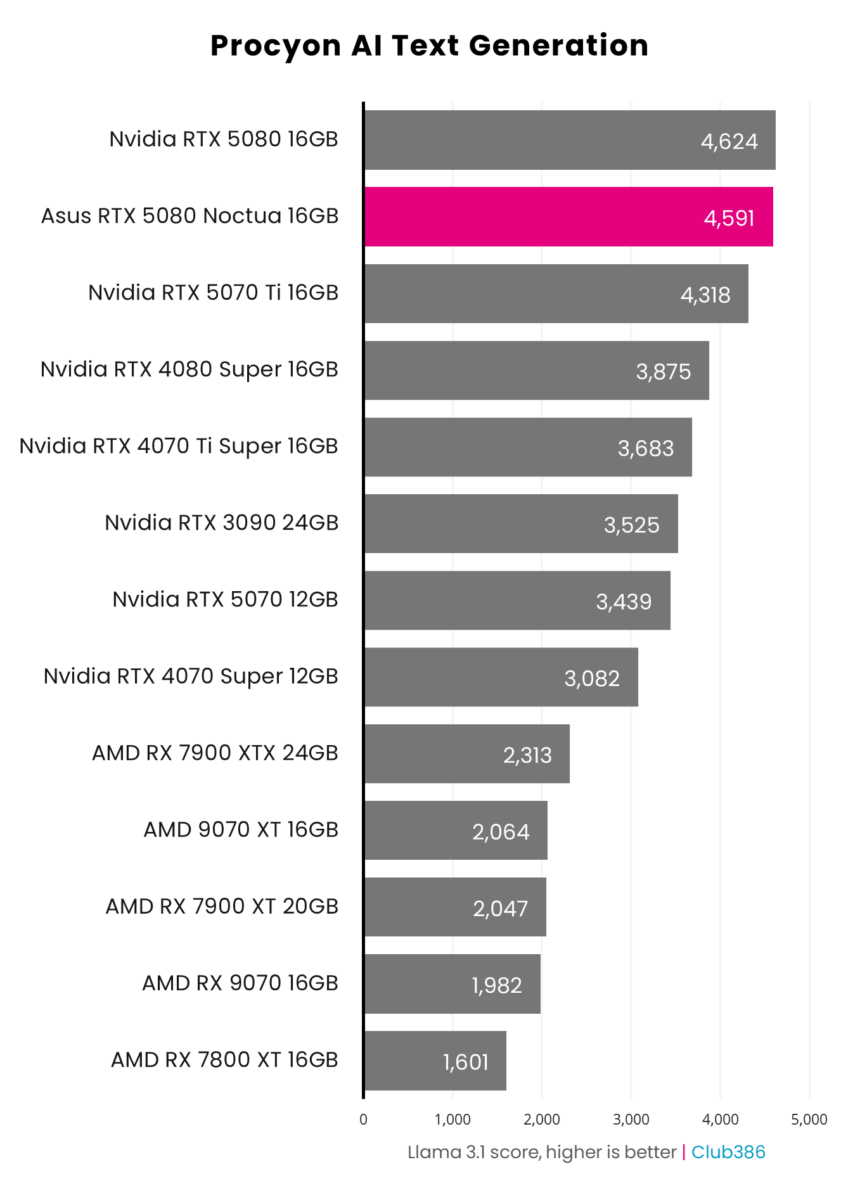
Llama 3.1 scores for RTX 5080 Noctua OC Edition in Procyon’s AI Text Generation benchmark are similarly just shy of Founders Edition. Once again, though, the differences between the two cards amount to splitting hairs.
Gaming
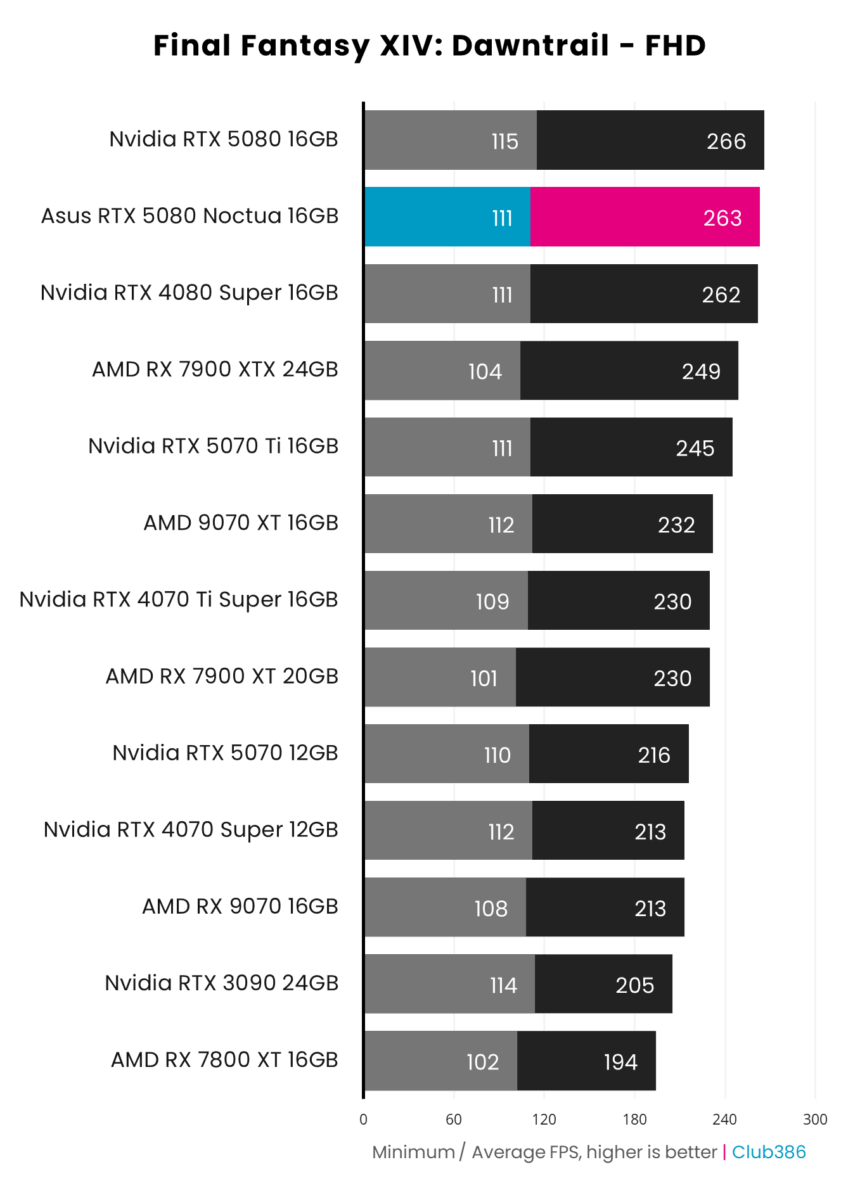
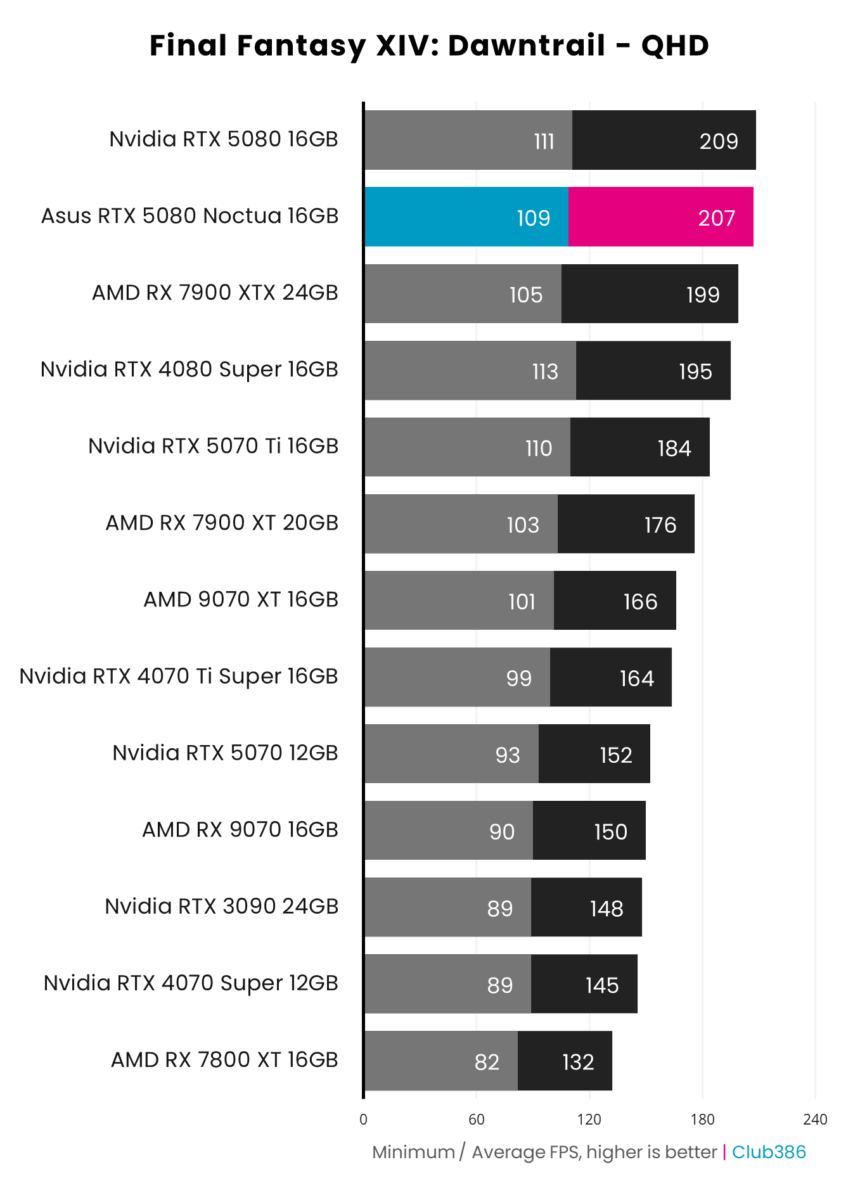
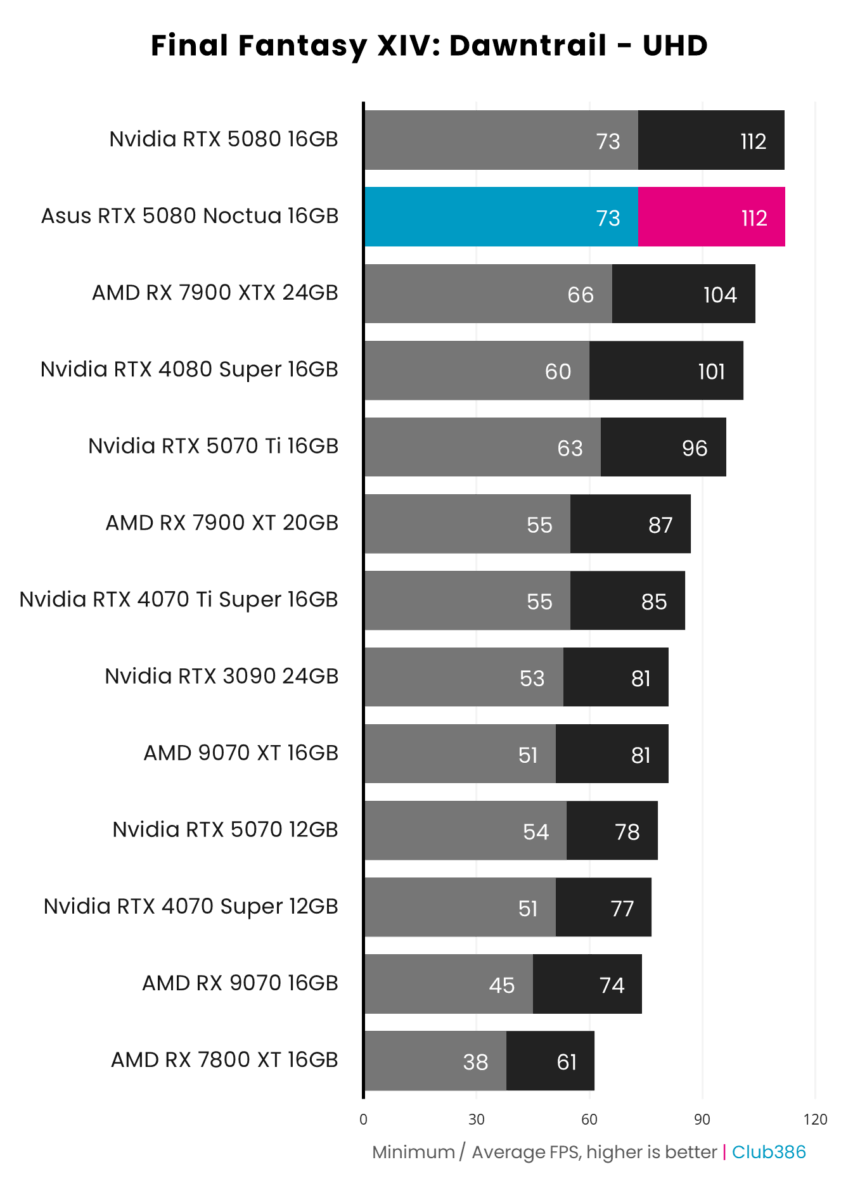
Turning attentions to gaming, Final Fantasy XIV: Dawntrail sees RTX 5080 Noctua OC Edition keep pace with Founders Edition. However, the custom card never exceeds the reference design in performance across all three resolutions, serving as a reminder that a dearer interpretation of the same GPU won’t shift the performance needle by any meaningful degree.
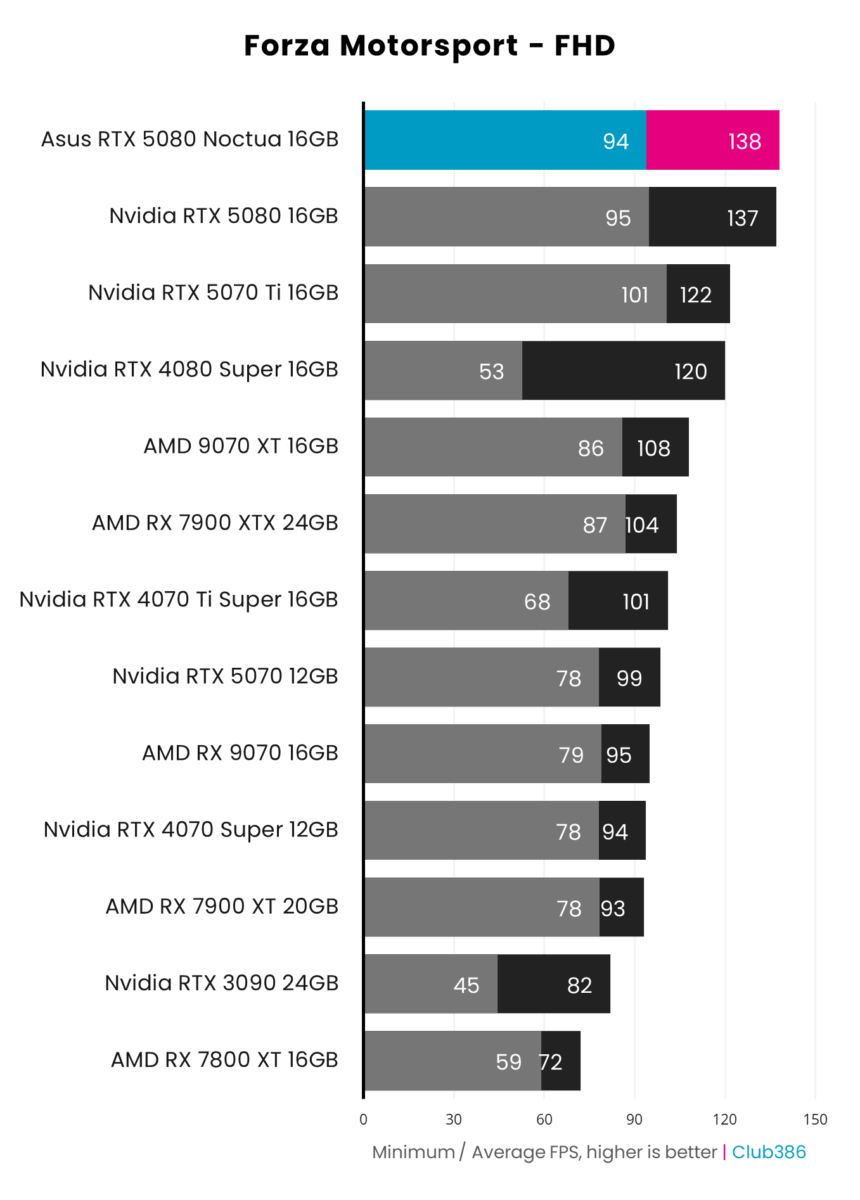
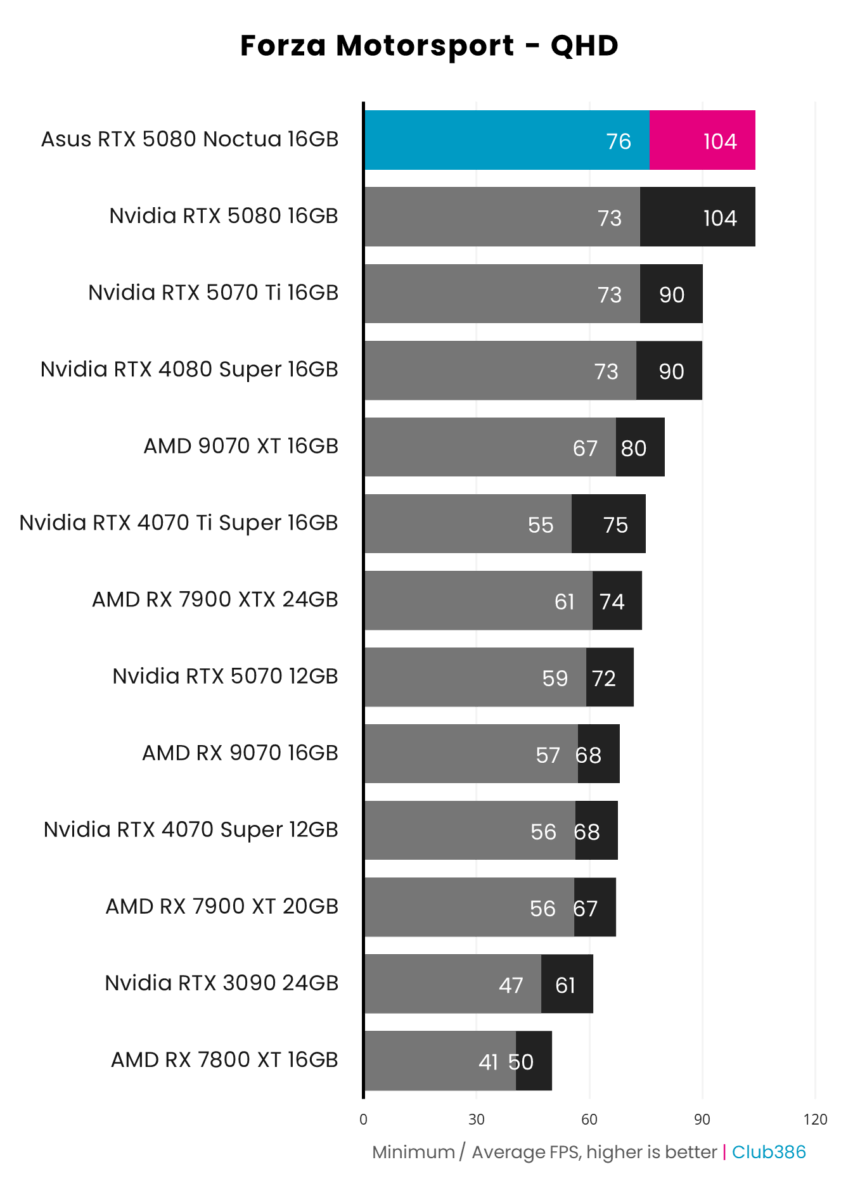
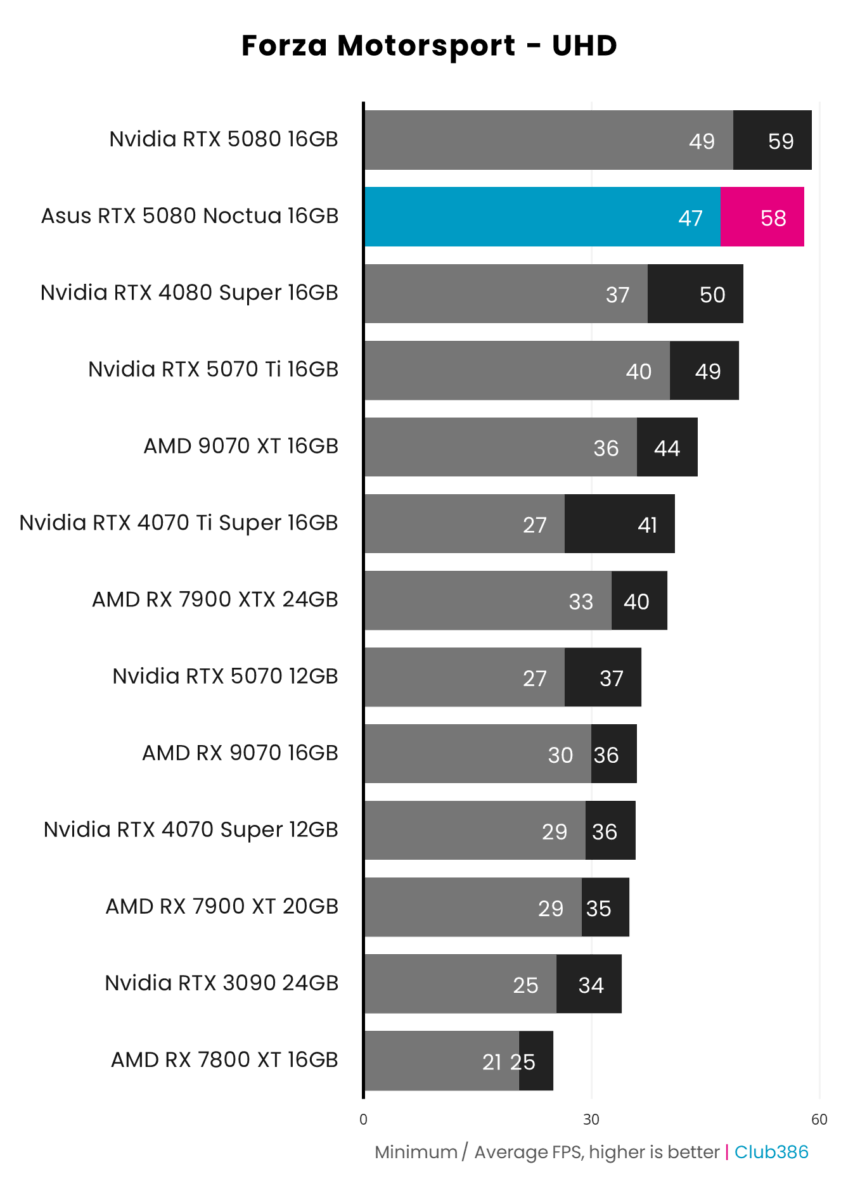
The story’s much the same when it comes to the ray traced race tracks of Forza Motorsport. Frame rates on RTX 5080 Noctua OC Edition practically mirror Founders Edition.
Vitals
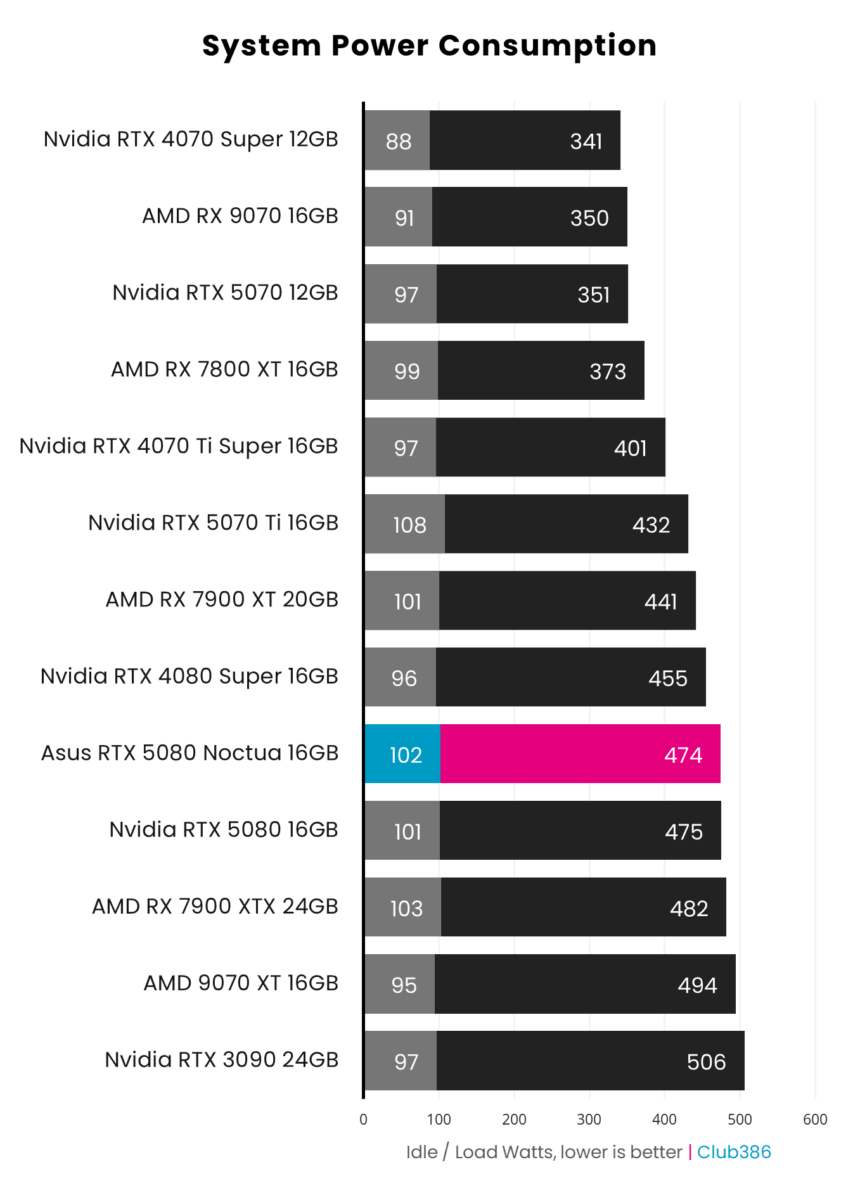
Out of the box, Noctua OC Edition power consumption is within expectations for stock RTX 5080. Asus’ PSU recommendations for this card fall in line with Nvidia’s at 850W.
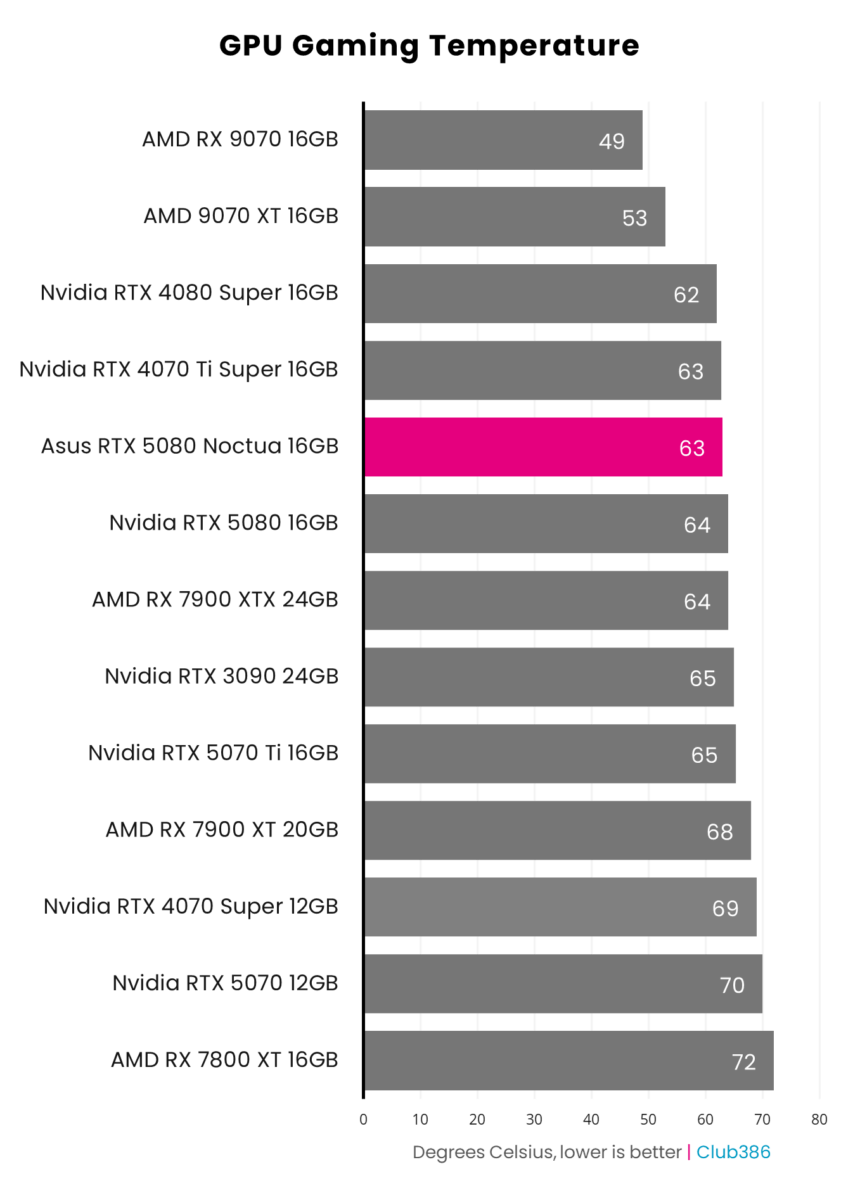
The sheer size and quality of RTX 5080 Noctua OC Edition’s heatsink and fans naturally nets great thermals. Better still, there’s plenty of headroom to bolster cooling further via the card’s P-Mode, which adopts a more aggressive fan curve and lowers core temperature to an impressive 57°C. That’s all well and good, but achieving low temps isn’t difficult for RTX 5080, the real trick is in keeping noise levels to an absolute minimum…
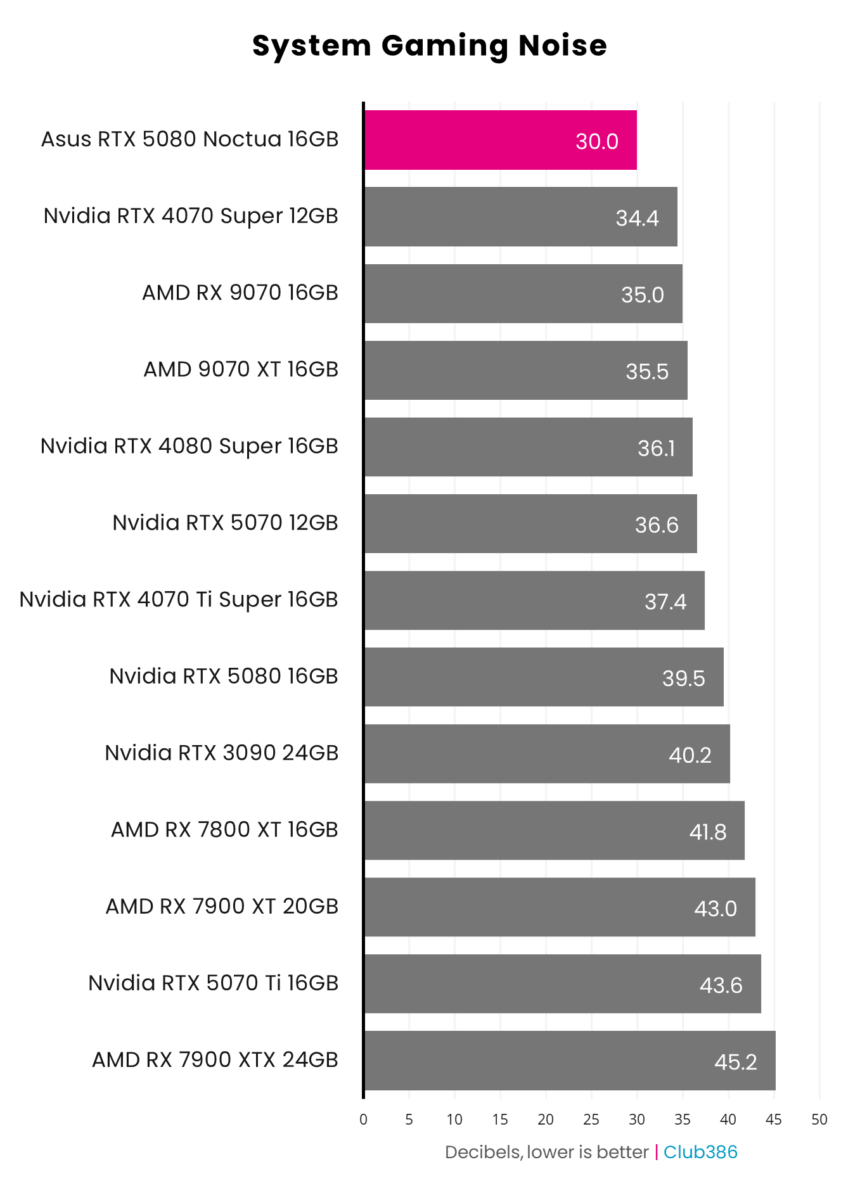
At last we come to the core appeal of RTX 5080 Noctua OC Edition, noise levels (or lack thereof). Even under the pressures of Alan Wake 2 complete with path tracing, this behemoth is practically inaudible in a normal room.
Operating at ≤30dBA is impressive for any graphics card, but is especially noteworthy for one with 360W coursing through it. It’s at once eerie and exciting to have the power of an RTX 5080 running silently at full pelt with no consequence to performance. Outstanding results, and a fine showcase of what a supersized card can do when tuned for no noise.
Overclocking
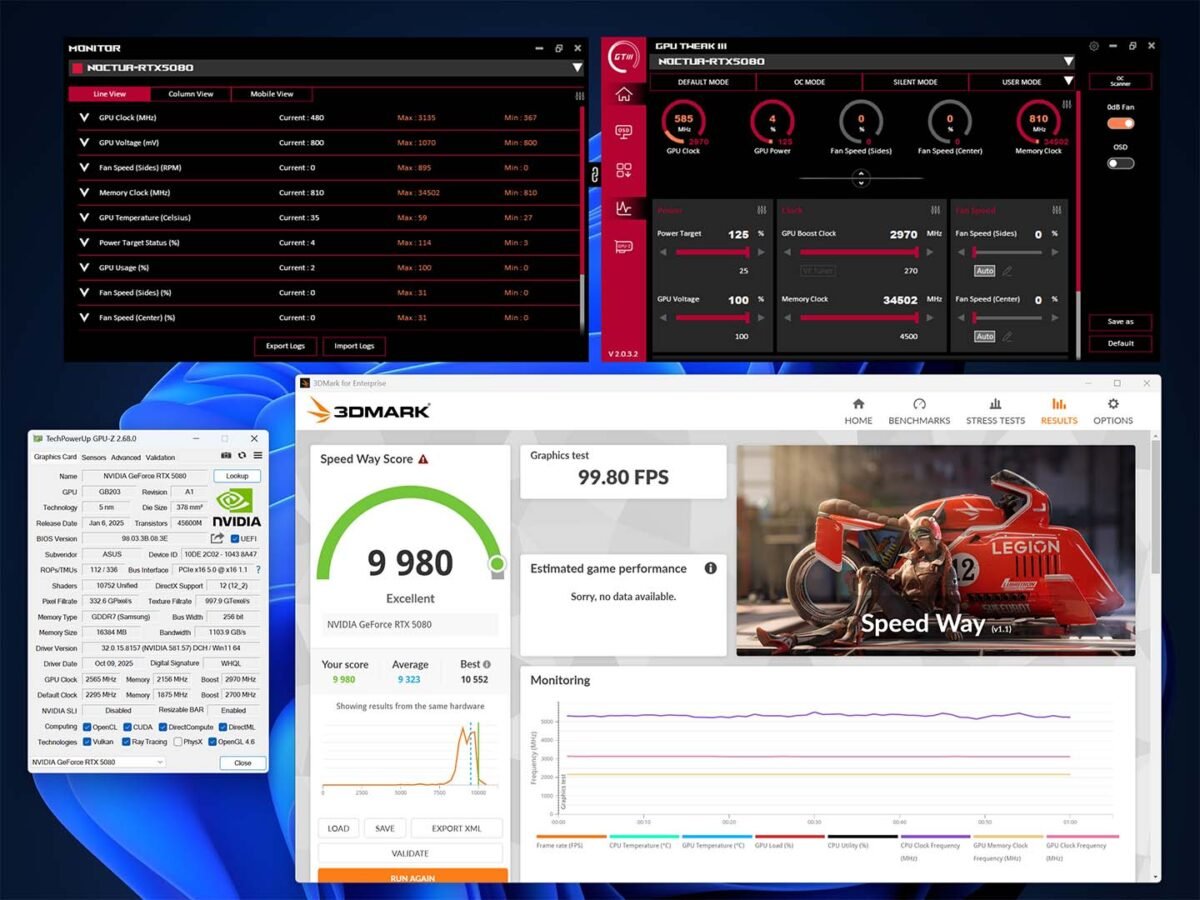
With such fabulous cooling at my disposal, squeezing extra performance from RTX 5080 Noctua OC Edition proves a straightforward and fruitful venture.
Through Asus’ GPU Tweak III, I’m able to raise GPU power target to 125%. Alongside this uplift, I push boost clocks up to 2,970MHz (+270) and memory speeds up to 34.5Gb/s.
Running 3DMark Speed Way with these overclocks results in a welcome 10% increase in score, as shown in the screenshot above. This is admittedly a quick and dirty overclock but indicates an awesomely stable setup.
Note, RTX 5080 Noctua OC Edition actually pushes beyond 2,970MHz under load, rising all the way to 3,135MHz. That’s an impressively chonky 16% (435MHz) above stock.
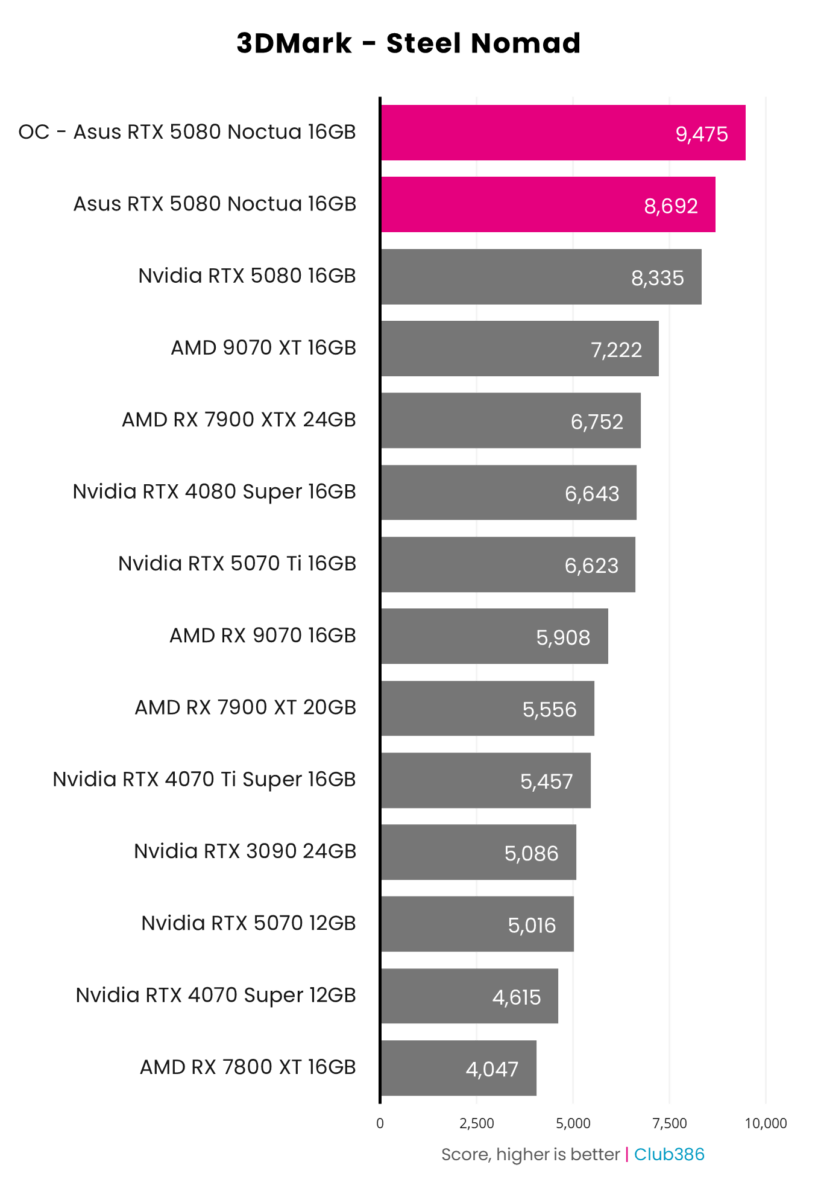
3DMark Steel Nomad scores also improve by a welcome 9% in the wake of my overclock.
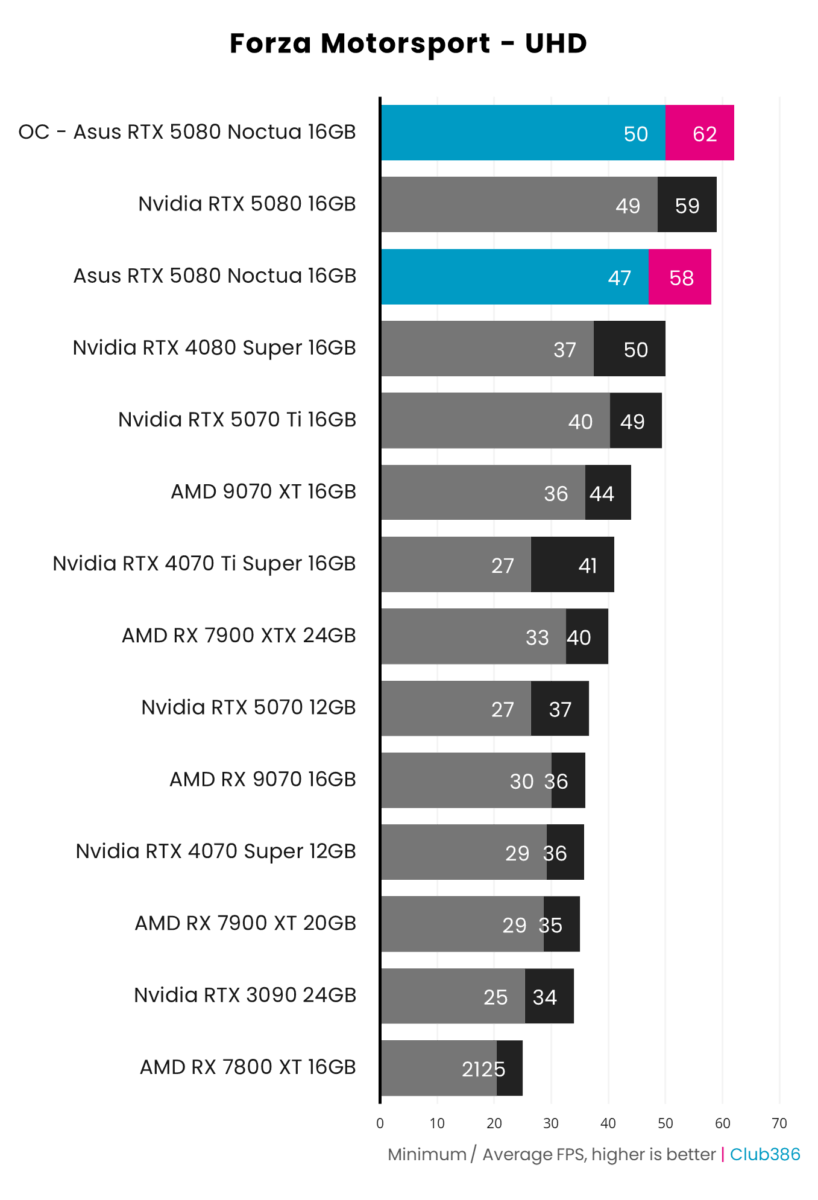
Average Forza Motorsport frame rates at UHD cross the finish line at 62fps thanks to the extra frequency headroom. That amounts to a 7% boost, or four additional frames.
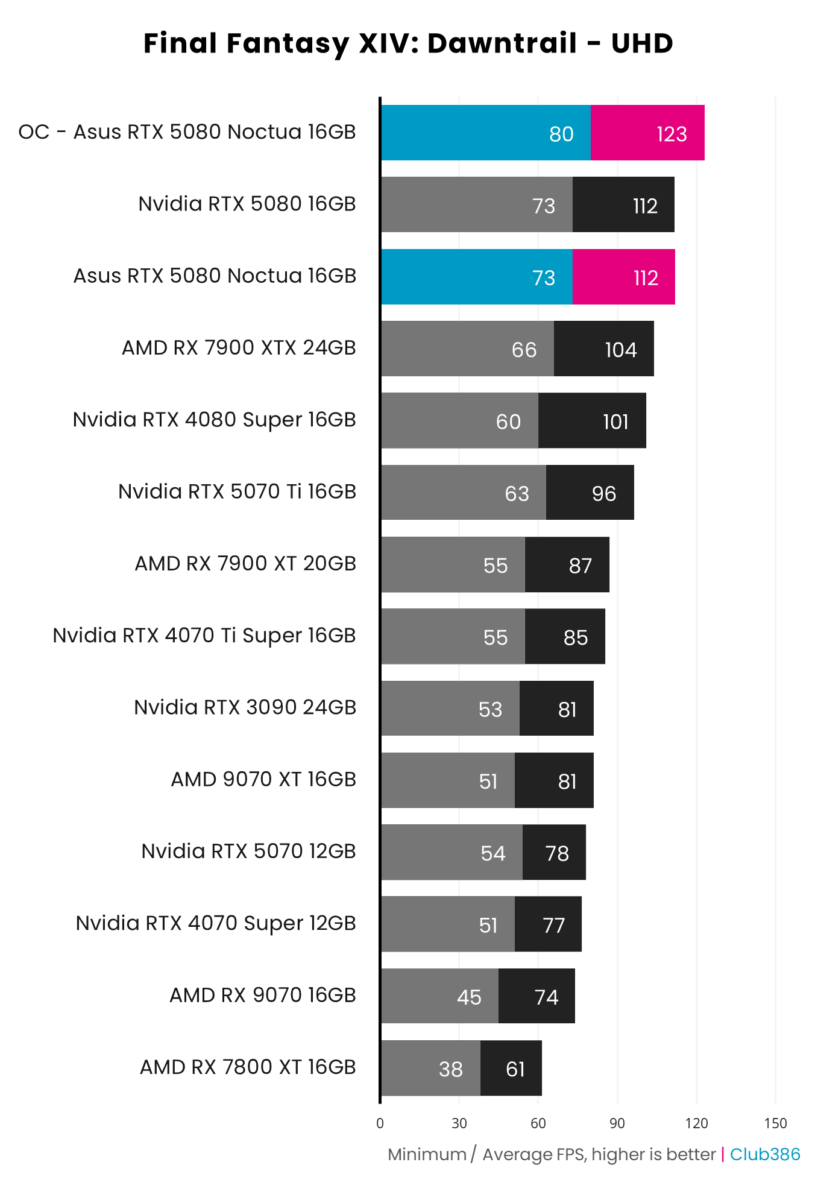
While synthetic benchmark results usually aren’t indicative of real-world performance, Final Fantasy XIV: Dawntrail is an exception to that rule and mirrors 3DMark Steel Nomad with a 9% improvement.
What’s impressive is that even when overclocked, this card barely makes a whimper, with noise output remaining below 30dBA. It’s one cool customer.
Conclusion
Asus GeForce RTX 5080 Noctua OC Edition is the PC equivalent of Nike’s 1989 Air Pressure gym shoes. One can’t help but admire the level of over-engineering, irrespective of bulky design and limited practicality.
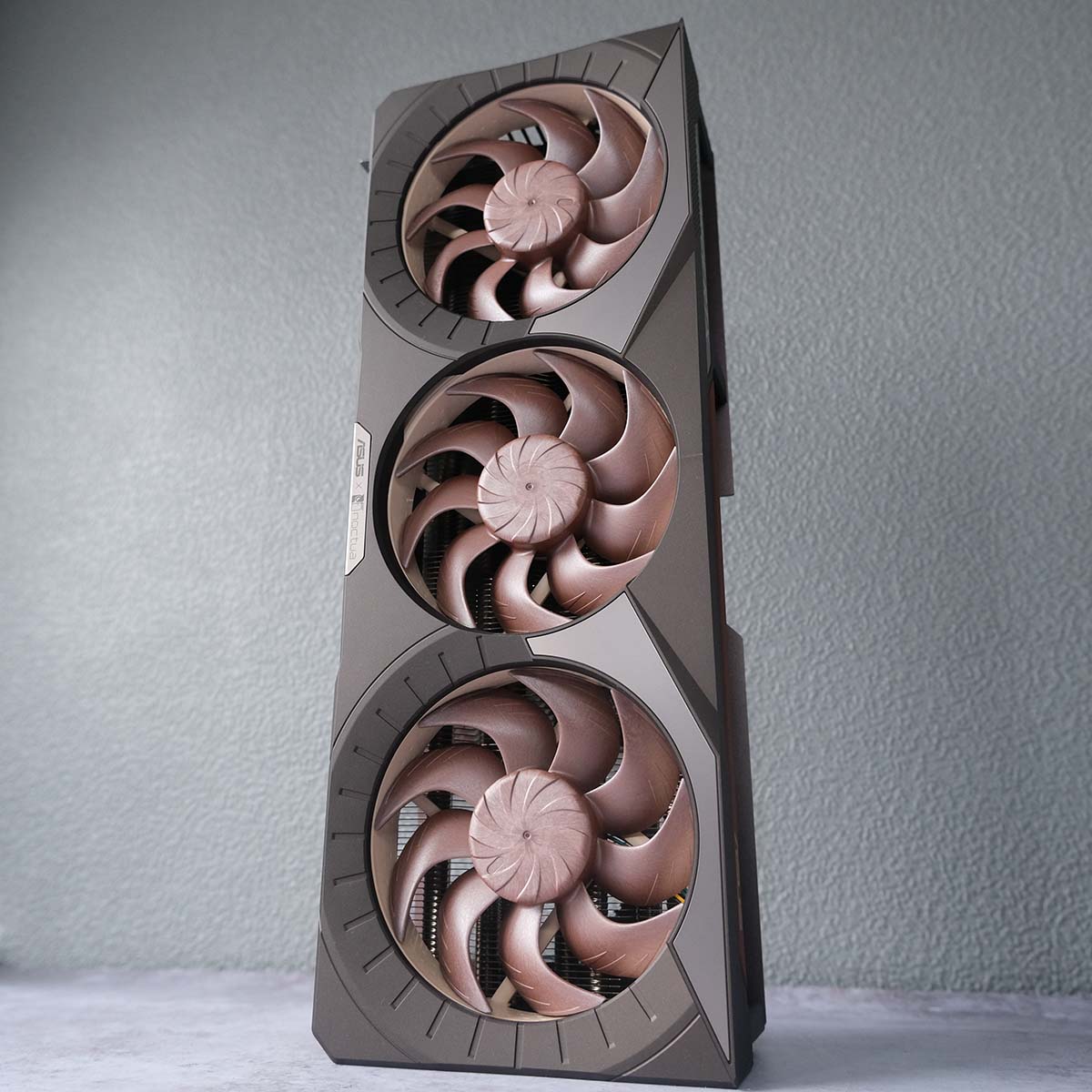
The graphics card’s laser focus on pushing noise levels down to unparalleled lows without compromising performance is impressive. It’s the core reason to even consider the pixel pusher, much as it also ticks the boxes when it comes to build quality, thermals, and overclocking potential.
However, paying the princely sum of £1,499 / $1,599 for the pleasure of near-silence from my RTX 5080 isn’t something that would sit comfortably with my wallet. I understand unique items like this should command a premium – I still hope to find a pair of Nike Air Pressures one day – but paying 50% over MSRP is a tall order and seriously hampers appeal.
I’d be less perturbed by the lofty price premium if this Noctua x Asus near-silent treatment is applied to the RTX 5090 instead, where value simply isn’t as important as other metrics that speak to a particular well-heeled enthusiast. In reality, wonderful over-engineering is applied to the wrong Nvidia GPU.
Nevertheless, having experienced the card gaming with barely a whisper, I can only appreciate the work that Asus and Noctua are doing through this continued collaboration, and would happily run this RTX 5080 in any system that could fit it. There truly is no substitute for this card, which isn’t something most custom cooling designs can claim. This one’s too rich for my blood, but if you’re happy to pay the premium you’ll make like Depeche Mode and enjoy the silence.

